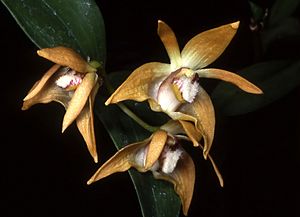Apricot cane orchid facts for kids
Quick facts for kids Apricot cane orchid |
|
|---|---|
 |
|
| Scientific classification | |
| Genus: |
Dendrobium
|
| Species: |
fleckeri
|
| Synonyms | |
|
|
The Apricot Cane Orchid (scientific name: Dendrobium fleckeri) is a beautiful type of orchid. It grows naturally in Far North Queensland, Australia. This orchid is special because it can grow on other plants, like trees, without harming them. This is called being an epiphyte. It can also grow on rocks, which is called being a lithophyte.
This orchid gets its name from its lovely apricot-colored or yellowish-green flowers. These flowers have a unique part called a labellum with interesting tangled white hairs on its edge.
What Does It Look Like?
The Apricot Cane Orchid is a plant that doesn't have a woody stem. It has special thick stems called pseudobulbs. These pseudobulbs are shaped like cylinders and are usually yellowish-green. They can be about 150–400 mm (6–20 in) long.
At the end of these pseudobulbs, you'll find two or three dark green leaves. These leaves are shaped like an egg and are about 50–80 mm (2–3 in) long.
Its Flowers
When the orchid blooms, a flowering stem grows from the end of the pseudobulb. This stem is usually 10–25 mm (0.4–1 in) long. It can have up to four flowers on it.
The flowers are typically apricot-colored, but sometimes they can be yellowish-green. Each flower is about 25–30 mm (0.98–1.2 in) long and wide.
- Sepals: Like many flowers, orchids have sepals, which are leaf-like parts that protect the flower bud. The top sepal (dorsal sepal) is about 14–17 mm (0.6–0.7 in) long. The side sepals are similar in length but a bit wider.
- Petals: The petals are the colorful parts of the flower. They are about 13–15 mm (0.51–0.59 in) long and 3 mm (0.12 in) wide.
- Labellum: The labellum is a special lip-like petal that often looks different from the others. On the Apricot Cane Orchid, the labellum is white with a hint of purple. It's about 10 mm (0.4 in) long and wide and has three parts, called lobes. The side lobes stand upright and are pointed. The middle lobe has three small ridges and is covered with thick hairs on its edges.
This beautiful orchid usually flowers between August and January.
How It Got Its Name
The scientific name for this orchid, Dendrobium fleckeri, was first officially described in 1937. Two scientists, Herman Rupp and Cyril Tenison White, wrote about it in a publication called The Queensland Naturalist.
The second part of its name, fleckeri, was chosen to honor a person named Hugo Flecker. He was a doctor and a natural historian. He also helped start the North Queensland Naturalists' Club.
Where Does It Grow?
The Apricot Cane Orchid lives in a special type of forest called a "mist forest." These forests are often covered in mist or fog, which provides the moisture the orchids need. You can find this orchid growing on trees, shrubs, and even large rocks between Mount Finnigan and Mount Fisher on the Cape York Peninsula in Australia.

